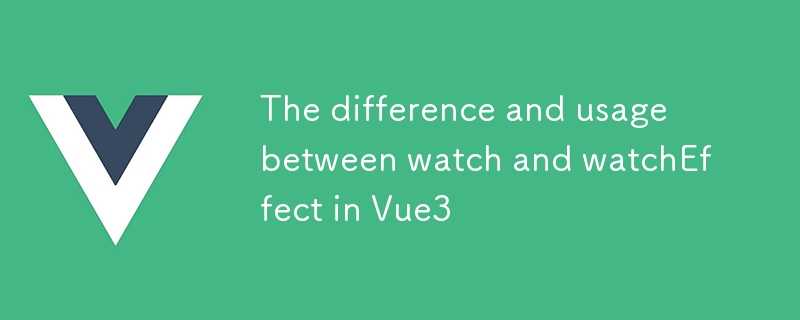Home >Web Front-end >Vue.js >The difference and usage between watch and watchEffect in Vue3
The difference and usage between watch and watchEffect in Vue3
- DDDOriginal
- 2024-08-13 15:34:201271browse
The article explores the differences between watch and watchEffect in Vue 3, highlighting their usage and functionality. watch is an immediate mode reactive function, called upon component mounting and data changes, while watchEffect is a lazy mode r

What are the distinct differences between watch and watchEffect in Vue3?
Vue3 introduces a new reactivity API that includes two new functions: watch and watchEffect. Both of these functions allow you to track changes to reactive state in your Vue components, but they do so in different ways. The main distinctions between the watch and watchEffect functions are:watch and watchEffect. Both of these functions allow you to track changes to reactive state in your Vue components, but they do so in different ways. The main distinctions between the watch and watchEffect functions are:
-
watchuses immediate mode reactive function, which means that the watcher function is called immediately after the component is mounted and whenever the observed data changes. -
watchEffectuses lazy mode reactive function which means that the effect function is only called when the observed data changes.
How do watch and watchEffect differ in their usage and functionality in Vue3?
watch
The watch function accepts two arguments:
- A string or an array of strings representing the reactive properties that you want to watch.
- A function that will be executed when the value of the observed properties changes.
<code>// Watch a single property
watch('count', () => {
console.log(`The count has changed to ${count}`);
});
// Watch multiple properties
watch(['count', 'message'], () => {
console.log(`The count or message has changed.`);
});</code>
watchEffect
The watchEffect function accepts only one argument:
- A function that will be executed when the observed data changes.
<code>watchEffect(() => {
console.log(`The count is now ${count}`);
});</code>
When and why would you choose to use watch or watchEffect in a Vue3 application?
You should use watch when you need to perform an action when the value of a specific reactive property changes. For example, you might use watch to update the UI when the value of a form input changes.
You should use watchEffect when you need to perform an action that depends on multiple reactive properties. For example, you might use watchEffect to calculate the total price of a product based on the quantity and unit price of the product.
In general, watchEffect is more efficient than watch because it only calls the effect function when the observed data changes. However, watch
-
watchuses immediate mode reactive function, which means that the watcher function is called immediately after the component is mounted and whenever the observed data changes. -
watchEffectuses lazy mode reactive function which means that the effect function is only called when the observed data changes.
watch function accepts two arguments:🎜- A string or an array of strings representing the reactive properties that you want to watch.
- A function that will be executed when the value of the observed properties changes.
watchEffect function accepts only one argument:🎜- A function that will be executed when the observed data changes.
watch when you need to perform an action when the value of a specific reactive property changes. For example, you might use watch to update the UI when the value of a form input changes.🎜🎜You should use watchEffect when you need to perform an action that depends on multiple reactive properties. For example, you might use watchEffect to calculate the total price of a product based on the quantity and unit price of the product.🎜🎜In general, watchEffect is more efficient than watch because it only calls the effect function when the observed data changes. However, watch is more concise and easier to read and understand.🎜The above is the detailed content of The difference and usage between watch and watchEffect in Vue3. For more information, please follow other related articles on the PHP Chinese website!
Related articles
See more- About vue using validator: VeeValidate3
- What are the differences between computed and method in Vue?
- Introduction to the method of turning off Eslint verification in the vue project
- Introduction to several methods of defining component templates in Vue.js
- Four places to implement AJAX in Vue applications

